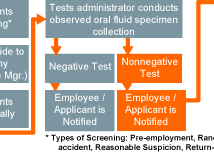1. Establish / Define Test Population (s)
Create test population(s): safety level / job function / department / location / etc.
Examples:
- All employees (recommended)
- Workers in safety sensitive positions only
2. Determine Percentages of Population to be Tested Annually
Establish percentage of population(s) to be tested (annual time period)
Examples:
- 50% of all employees tested (recommended)
- 30% of all employees tested
- 25% of all employees tested
- 50% of safety sensitive employees only test annually
3. Outline Test Frequency
Establish Screening Frequency
Examples:
- 50% of all employees tested (recommended)
- Time-based (Weekly, Monthly, Quarterly)
- Activity-based (Coming on/off shift)
4. Establish Random Selection Process
A. Develop a method for random selection of employees within established groups. This is done using a random number generator (employee number or social security number), also referred to as a randomizer. This software uses appropriate internal random number generation logarithms and provides employees with an equal chance of being selected within the specified target population each time the list is queried.
B. Assign responsibility for creation of the list of employees to be tested. For example will the list be built at a central location and distributed (recommended), or generated on local basis.
5. Notification of Employees
A. The Test administrator and/or local office are provided with list of employees to be tested. Employees are confidentially notified within 30 minutes of screening.
B. Tests are conducted by, and in presence of a trained test administrator (supervisor, human resources, safety or medical staff, third party). All test administrators should be trained, experienced, and appropriately certified in the use of the specified drug screen and associated procedures.
C. Results recorded by test administrator
6. Negative Result
Employee returns to work per corporate drug policy.
7. Non-negative Result
Per corporate drug policy, additional requisite sample quantity is received from the employee for a GC/MS confirmatory test to be done at a designed laboratory. Chain of custody information form and other required forms are completed by test administrator, and copies sent with the confirmatory sample to the laboratory. The laboratory should be able to identify any of the specific illegal drugs being tested for via the on-site test, and/ or their metabolites.
Examples:
- 50% of all employees tested (recommended)
8. Laboratory Confirmation Test
Laboratory conducts confirmatory test using approved GC/MS equipment and procedures, and then notifies MRO (Medical Review Officer-see below) and/or employer of the results. (If MRO contact is not present, laboratory should communicate directly with employer to assure appropriate individuals are notified of confirmatory test results.
9. MRO Review
Many employers use the services of a physician known as a Medical Review Officer (MRO) to review results obtained from a non-negative GC/MS confirmatory test to determine the potential involvement of legal medications, and assure that the corporation and laboratory involved observed appropriate technical and administrative procedures. The MRO has the ability, for example, to differentiate legitimate therapeutic drug use from illicit drug use.
Many employers use the services of a physician known as a Medical Review Officer (MRO) to review results obtained from a non-negative GC/MS confirmatory test to determine the potential involvement of legal medications, and assure that the corporation and laboratory involved observed appropriate technical and administrative procedures. The MRO has the ability, for example, to differentiate legitimate therapeutic drug use from illicit drug use.
The MRO makes a final determination whether the laboratory test is to be judged as a confirmed POSTIVE or NEGATIVE, and communicates the information to the employer. N0TE: Employers regulated by the Department of Transportation are required to use an MRO.
A confirmed result (fax, mail, electronic and/or web-based notification) is delivered by the MRO to the appropriate contact at the employer, typically within two to three days of the sample being received by the laboratory, and appropriate communication between the donor and the MRO.
Procedures should be established to maintain confidentiality, by the laboratory, the company, and the MRO, and employer actions should never be based upon an on-site drug screen or a verbal laboratory or MRO communication.
Checklist of Required Items (for example only)
Laboratory conducts confirmatory test using approved GC/MS equipment and procedures, and then notifies MRO (Medical Review Officer-see below) and/or employer of the results. (If MRO contact is not present, laboratory should communicate directly with employer to assure appropriate individuals are notified of confirmatory test results.
 |
Drug Screening Policy |
 |
Drug Screening Program |
 |
On-site drug screening devices |
 |
Documentation: |
| |
Directions for Use |
| |
Consent and Result Reporting Form |
| |
Chain of Custody Form |
 |
Random number generator (software) |
 |
Centralized Information Storage (hardcopy or software) |
 |
Confirmatory Test Kits |
 |
GC/MS Confirmatory Testing Laboratory |
 |
MRO |

Top
|






